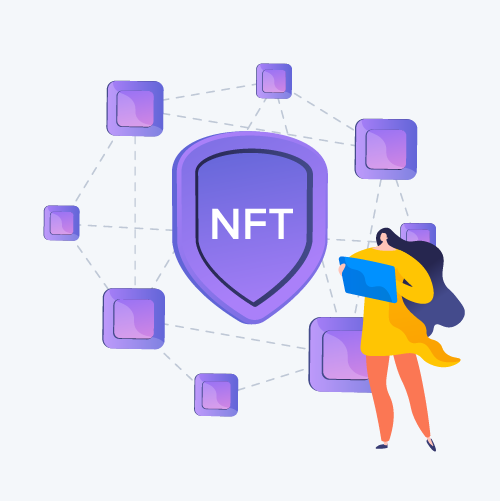
With the rise of digital content, from music to gifs to art to tweets, it was only a matter of time before someone found a way to monetize it. After all, a non-fungible token (NFT), recently sold for $69 million, one of the top paydays for a living artist.
Sounds lucrative, right? First, you need to understand what NFTs are and why they’re so important today.
What Are NFTs?
So what are NFTs and how can you capitalize on this digital content? NFTs are a form of cryptographic assets that you can create, buy, and sell–endlessly. They are unique files that live on a blockchain with unique identification codes and metadata that distinguish them from each other.
Unlike cryptocurrencies, NFTs cannot be traded or exchanged at equivalency. This differs from fungible tokens (like bitcoin), which are identical to each other and can be used as a medium for commercial transactions.
Non-fungible Tokens are a means to build digital assets that use blockchain to issue and track absolute digital goods or properties. They are niche, as they are scarce and are driven by the market forces of demand and supply.
Some experts are comparing the virtual popularity of NFTs to standing in line to get the latest Air Jordans at the shoe store. With the Air Jordans, you’re getting something that’s limited to a specific product run. But when you buy an NFT, you buy a barcode that certifies you are the owner of that particular–original, one-of-a-kind digital asset.
And while it’s incredibly easy to copy digital images online and save them to your own computer, that’s a copy, not the original. Just like the copy of van Gogh’s Starry Night isn’t worth much, the original is worth millions. The same idea applies to NFTs.
NFTs are becoming increasingly popular as an asset class with the entry of several popular personalities and agencies as collectors. It’s an industry that started with a mere $31 Million market cap back in 2017 but has skyrocketed to over $338M with a CAGR of 187.28% by the end of 2020.
Unique Features of NFT
Indivisibility
Unlike the popular currencies in place, which can be shown in denominations, NFTs are indivisible. They remain as a complete entity.
Non-exchangeable
Since each piece of content built as an NFT possesses its own unique features, they are not inter-exchangeable. They are built to be originals and live on the blockchain, giving the ownership rights to the piece.
Indestructible
NFT data is stored on the blockchain via smart contracts and it is not possible to destroy, remove or replicate. Ownership of these tokens also remains immutable. Gamers and collectors who possess NFTs retain their ownership on the one they purchased but not the companies that create them. They can sell it for a higher price whenever they wish to. This is a complete contrast to a case when a customer purchases music. He neither owns the company nor copyrights over the music. As a customer, he can just enjoy the music without any ownership.
Verifiable
Since NFTs store historical data on the blockchain, attributing ownership over a digital art piece or virtual land to its creator, it remains indestructible and immutable and can be easily traced. The art piece remains authenticated without the need for any third-party verification.
Scarce and Expensive
The NBA has partnered with Canadian-based Dapper Labs, the makers of the CryptoKitties game to enter into the trading card marketplace. Irrespective of the number of cards the NBA had issued, a video clip of LeBron James dunking was recently sold for $200,000 and a Zion Williamson edition was sold for $750,000 at Golden Auction in January. Clearly, there are die-hard admirers and collectors who are ready to spend big dollars to own the digital assets of their favorite players. Sports NFTs are like baseball card collecting on steroids.
Why Have NFTs Gained Popularity?
NFT is becoming increasingly popular among companies and individuals alike for obvious reasons; it has completely revolutionized the concept of online gaming and digital arts by adding authenticity to the ownership that remains immutable.
For example, Decentraland is an Ethereum-based 3D world that started in December 2020. It’s owned by its users and governed by Decentralized Autonomous Organization (DAO). Anybody can explore this metaverse utilizing two ethereum tokens. Users can purchase virtual land, goods, and services with NFTs. They can also explore virtual valleys, gardens, digital art galleries, and games.
Are NFTs The Next Big Thing?
The monetization potential of NFTs is attracting individuals to bid for digital artifacts for ever-higher prices. Creators and developers can build and monetize unique structures like casinos, theme parks like Sandbox, or virtual worlds like Decentraland for sale.
A gamer on the Decentraland’s virtual platform recently purchased 64 lots and sold them as a single estate, titled ‘The Secrets of Satoshis Tea Garden,’ for $80,000 due to its desirable location and road access. Another investor purchased a segment of a digital Monaco racing track in the F1 Delta Time game for $222,000. He will get 5% dividends from all races that take place on it, including entry ticket fees. And Nyan Cat creator Chris Torres has sold his meme as an NFT for $600,000. He is now launching an event called “Memeeconomy” to sell other popular memes like “Keyboard Cat” and “Bad Luck Brian” via auction.
Artists can sell their artworks in digital form as NFT in virtual art galleries directly without having to pay for auction houses that deduct a significant amount of auction money, making them a lucrative option for artists who want to monetize their art. Creators get a percentage as royalty each time their artwork is sold to a new owner.
William Shatner from “Star Trek,” for example ventured into digital collectibles in 2020 and issued 90,000 digital cards on the WAX blockchain, showcasing his images. Each card was initially sold for $1. Now it is providing Shatner a passive royalty income every time his images are resold. Rare CryptoPunks are sold for over $1 million and a chunk of “land” in the game Axie Infinity fetched 888 ETH (over $3 million as of this writing) for its owner. Canadian musician and singer Grimes also opted into the NFT rush, selling $6 million worth of digital artworks, which included images, short videos, and music in February 2021. The video titled “Death of the Old” alone fetched her $389,000.
How to create NFTs?
NFTs aren’t limited to digital art. Both tangible and intangible articles, properties like land or houses, documents, certificates, artwork, music, video, and metaverse themes and concepts can be created as NFT.
It’s about having a digital asset that is of value to others and making it available for sale on a blockchain service, like Ethereum.
Demonstration of Creating and Selling NFT
Having decided the standards, several NFT-centric platforms allow individuals to create a wallet of their choice and upload the chosen image or file that ought to be turned into an NFT. A listed artist in any of the Marketplace can create and own an NFT. If the artist has digital art ready to sell, he should follow the below-mentioned steps.
.
Digital Wallet
Before getting into buying or selling NFT, an individual needs to create a digital wallet. Since Ether is a popular cryptocurrency, available on major marketplaces, it is desirable to buy and save it in a digital wallet.
As of May 2021, Ether is equal to almost $4,000 US. There’s a lot to consider when buying Ethereum, including which blockchain provider you plan to use. There are wide ranges of other blockchain services like Binance Smart Chain, Flow, Tron, EOS, Polkadot, Tezos, Cosmos, and WAX. Each blockchain follows its own NFT standard, such as compatible wallet services and marketplace for trading.
If you are buying Ether in OpenSea, for example, you need to download a plug-in called MetaMask into Chrome or any other browser of your choice to create a digital wallet, which can be connected to your ‘OpenSea’ account. You need to buy Ether and deposit it in your digital wallet for any transaction.
How to Buy NFT?
One who decides to buy an NFT can get into any of the popular marketplaces like OpenSea to explore the ‘galleries’ that display a variety of images, cards, themes, and concepts for sale. They may be either put on rotation or may emerge as flashing icons. Select a product/image of your choice and click “Buy Now.” Check out and submit your order. Pay the Gas Fee to confirm the Ethereum network to process your transaction.
Now you have become the proud owner of an NFT. Your transaction and ownership details are registered in a digital ledger that adds authentication to the digital file you purchased with a digital signature, which tracks your NFT ownership across the globe.
Future of NFT
NFTs have redefined the meaning of asset creation and infrastructure building as they are offering a decentralized, blockchain-based financial system that does not rely on intermediaries like brokerages, stock exchanges, and banks. NFTs rely on smart contracts on blockchains and the most common among them is Ethereum. Important documents like passports and transcripts can be digitized to ensure easy identity management.
Apart from decentralization, NFTs are also democratizing land ownership on the virtual front, as it is much easier to divide a digital real estate asset among multiple owners than a physical one. It is possible to simplify the complex real estate trading, eliminating bureaucracy by incorporating relevant metadata into each unique NFT. Hence, we see a bright future for the NFT market in the coming years.
Final Thoughts
NFT as an industry has to go a long way, as it is still in its infancy and not accessible to mainstream users. But there is so much potential. In the future, we expect improved platforms and technology as well as new applications that can support larger numbers of transactions to make it more sustainable. In the end, we think NFT could definitely be a game-changer. If you liked our article, explore our blog to read more informative content like this!
